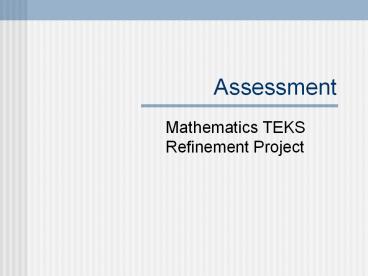Assessment - PowerPoint PPT Presentation
1 / 22
Title:
Assessment
Description:
The factory enlarged it by a scale factor of 3 to make a similar prism. ... Feijs, de Lange, Standards-Based Mathematics Assessment in Middle School ... – PowerPoint PPT presentation
Number of Views:62
Avg rating:3.0/5.0
Title: Assessment
1
Assessment
- Mathematics TEKS Refinement Project
2
Assessment
3
Assessment
Lower level - reproduction, procedures, concepts,
definitions
4
Assessment
Middle level - connections and integration for
problem solving
5
Assessment
Higher level - mathematization, mathematical
thinking, generalization, insight
6
Consider the following
- A rectangular prism is 2cm x 4cm by 6cm. One
dimension is enlarged by a scale factor of 3.
What is the volume of the enlarged figure? - A rectangular prism is 2.7cm x 0.45cm by
609.01cm. One dimension is enlarged by a scale
factor of 3.5. What is the volume of the
enlarged figure? - When a figure is dilated by a scale factor k to
form a similar figure, the ratio of the areas of
the two figures is ___ ___ . - A certain rectangular prism can be painted with n
liters of paint. The factory enlarged it by a
scale factor of 3 to make a similar prism. How
much paint do they need to paint the larger box?
7
Assessment Items - Where?
8
Assessment Items - Where?
- A rectangular prism is 2cm x 4cm by 6cm. One
dimension is enlarged by a scale factor of 3.
What is the volume of the enlarged figure? - A rectangular prism is 2.7cm x 0.45cm by
609.01cm. One dimension is enlarged by a scale
factor of 3.5. What is the volume of the
enlarged figure? - When a figure is dilated by a scale factor k to
form a similar figure, the ratio of the areas of
the two figures is ___ ___ . - A certain rectangular prism can be painted with n
liters of paint. The factory enlarged it by a
scale factor of 3 to make a similar prism. How
much paint do they need to paint the larger box?
9
Your Assessment Items - Where?
- Teacher questioning?
- Homework?
- Quizzes?
- Tests?
10
Guiding Questions
- How can I formulate balanced assessments?
- How can I ask questions for which students can
not just memorize their way through? How can I
ask questions that demand that students actually
understand what is going on? - How can I ask questions that students can learn
from while answering? - How can I make sure that I have higher level
reasoning questions and not just more
computationally difficult questions?
11
Passive Assessment Expertise
- Understanding the role of the problem context
- Judging whether the task format fits the goal of
the assessment - Judging the appropriate level of formality (ie.,
informal, preformal, or formal) - Judging the level of mathematical thinking
involved in the solution of an assessment problem - Feijs, de Lange, Standards-Based Mathematics
Assessment in Middle School
12
The Assessment Principle
- Assessment should become a routine part of the
ongoing classroom activity rather than an
interruption. - NCTMs Principles and Standards for School
Mathematics (2000)
13
TAKS Item 9th grade 2004
Tony and Edwin each built a rectangular garden.
Tonys garden is twice as long and twice as wide
as Edwins garden. If the area of Edwins garden
is 600 square feet, what is the area of Tonys
garden?
14
Our focus
- Think about current classroom assessments
- How can they improve?
15
Take one typical assessment
- What is the purpose of the assessment?
- Where are the items in the pyramid?
- Are you satisfied with the balance?
16
Changing existing questions
- to higher leveling reasoning
- to concept questions
- maintain balance between concept and skill
questions - shift focus from what students do not know to
what they do know
17
Targeted Content
- (A.2) Foundations for functions. The student uses
the properties and attributes of functions. The
student is expected to (D) collect and organize
data, make and interpret scatterplots (including
recognizing positive, negative, or no correlation
for data approximating linear situations), and
model predict, and make decisions and critical
judgments in problem situations. vocabulary of
zeros of functions, intercepts, roots
18
Targeted Content
- (A.4)(C) connect equation notation with function
notation, such as y x 1 and f(x) x 1.
19
Targeted Content
- (G.11) Similarity and the geometry of shape. The
student applies the concepts of similarity and
justifies properties of figures and solves
problems. The student is expected to (D)
describe the effect on perimeter, area, and
volume when one or more dimensions of a figure
are changed and apply this idea in solving
problems.
20
Targeted Content
- (G.6) Dimensionality and the geometry of
location. The student analyzes the relationship
between three-dimensional geometric figures and
related two-dimensional representations and uses
these representations to solve problems. The
student is expected to C) use orthographic and
isometric views of three-dimensional geometric
figures to represent and construct
three-dimensional geometric figures and solve
problems.
21
So, lets look at some ways to improve
22
Consider the following
- Factor x2 - 5x - 6
- Factor 36x2 45x - 25
- A soccer goalie kicks the ball from the ground.
It lands after 2 seconds, reaching a maximum
height of 4.9 meters. Write the function that
models the relationship (time, height). - Define root of an equation.































